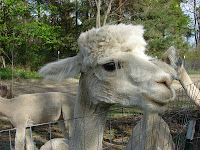 I love small one-topic museums like
the Jell-O Museum. The story of Jell-O
points out the importance of marketing. A gelatin product was developed by
Peter Cooper in 1845 but it wasn’t a success until, in 1897, Pearle Wait added
flavor calling it Jell-O. Wait then sold his formula to Frank Woodward for $450.
In 1899 Woodward sent well-trained
salesmen, in "spanking rigs, drawn by beautiful horses” with his product
to fairs, country gatherings, and church socials. He promoted the new
product as a way to make dessert preparation easier for the housewife. As the
saying goes, the rest is history - it became "America's Most Famous
Dessert." A new exhibit reflects the influence
of Bill Cosby as the Jell-O spokesperson.
I love small one-topic museums like
the Jell-O Museum. The story of Jell-O
points out the importance of marketing. A gelatin product was developed by
Peter Cooper in 1845 but it wasn’t a success until, in 1897, Pearle Wait added
flavor calling it Jell-O. Wait then sold his formula to Frank Woodward for $450.
In 1899 Woodward sent well-trained
salesmen, in "spanking rigs, drawn by beautiful horses” with his product
to fairs, country gatherings, and church socials. He promoted the new
product as a way to make dessert preparation easier for the housewife. As the
saying goes, the rest is history - it became "America's Most Famous
Dessert." A new exhibit reflects the influence
of Bill Cosby as the Jell-O spokesperson.
In the
lower level of the building that houses the Jell-O Museum is a Transportation
Museum depicting the evolution of transportation during the 20th century. And, in front of the building is the historic
Le Roy House. Built in 1822 for a land agent, the house has a working hearth
fireplace in the basement and three floors that afford a view of life during
the 1800s. One of the owners of the
house was the chancellor of Ingham University which was the first female
university in the United States to grant women a four-year degree. The university closed in 1892.
While chatting with Lynne Belluscio, the
curator, I mentioned that
Le Roy was a lovely town. She said, “Yes, we have a lot to offer. And,
you don’t have to go all the way to New York City to see the Statue of
Liberty. We have one of our own.” She
motioned toward the pretty pond and, yes, there was the six-foot statue. I thought there were only two – the one in NY
harbor and the one in France. I was surprised to learn from a Web search that
there are hundreds of similar statues all over the world.
While we
were in Le Roy we picked up two driving brochures and set out. One guide took us on the 17-mile tour that
explores Le Roy’s involvement in the Underground Railroad and the other on a
Quilt Trail. The Quilt Trail is a great
idea. There are a slew of barns and
garages that have painted quilt designs on them – some traditional, some
whimsical. It is a great way to get visitors to do a drive-about.
I like
drive-abouts. The countryside is
beautiful – especially in the
Northeast.
We stopped at an alpaca farm, there are several in the area. There is elegance to the stance of
alpacas. People are now raising alpacas for their wool-like fiber that can be
fashioned into sweaters, blankets and other spun items. Alpaca fiber is soft,
durable, and silky. It is similar to wool but warmer, not itchy and
lanolin-free making it hypoallergenic. We also stopped for a little wine tasting and
cheese at Kutter’s Cheese Factory and Store in Corfu. The family owned cheese
factory was started in 1923 and is now owned and operated by the third
generation.
Our last stop for the day was Indian
Falls Log Cabin Restaurant and Bar which came highly recommended. It is located
in a quiet rural area with a view of the waterfalls and great food. The area
was once part of the Tonawanda Indian Reservation. If we lived closer this would be one of my
favorite restaurants.




